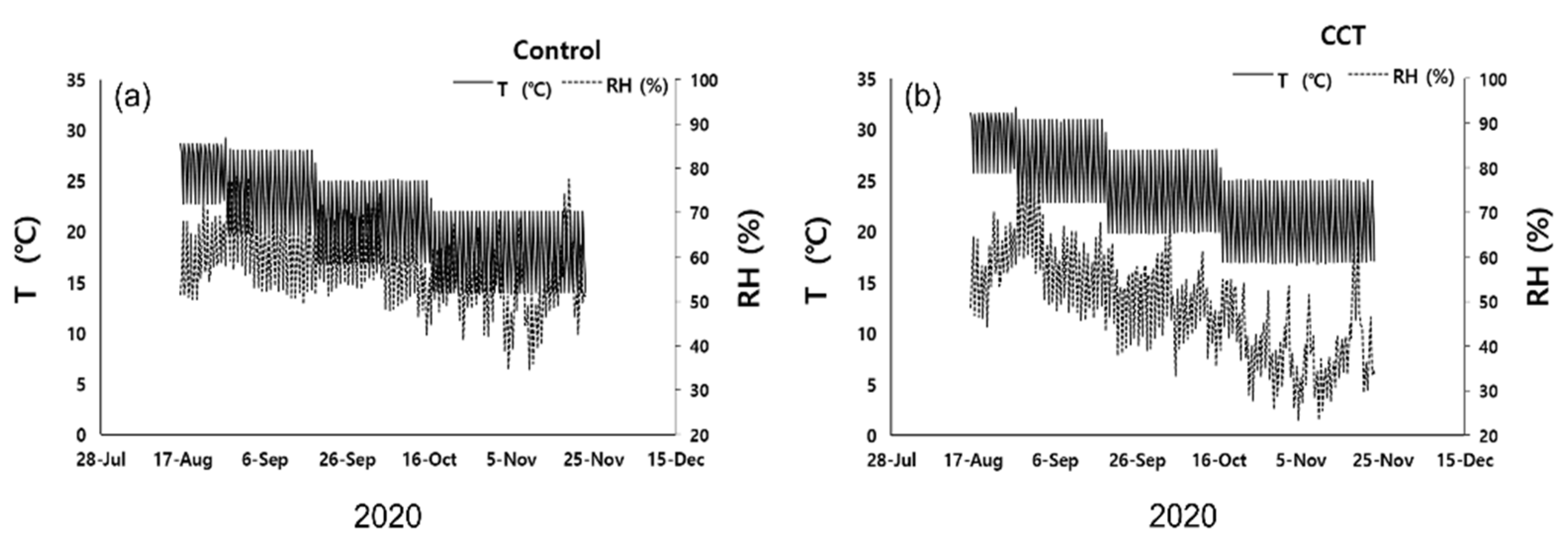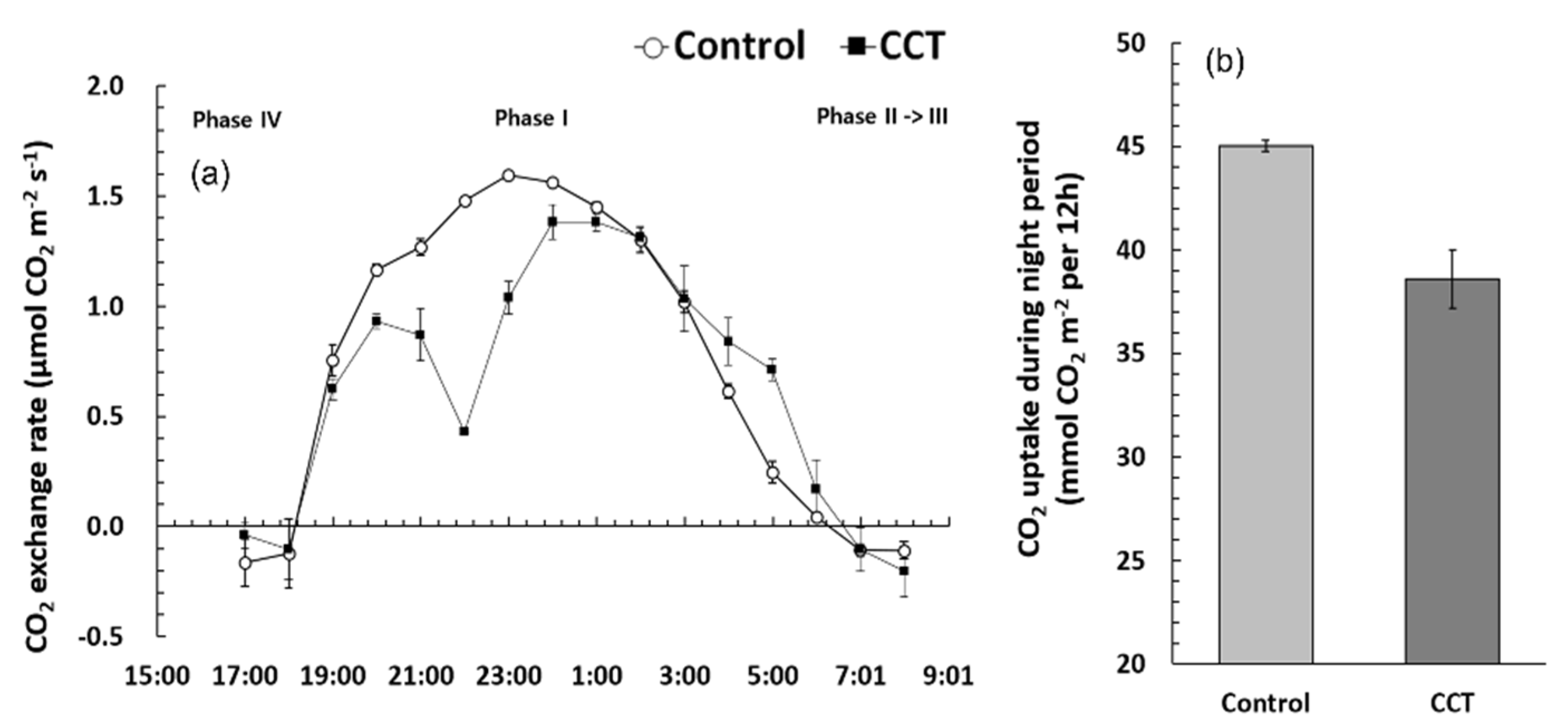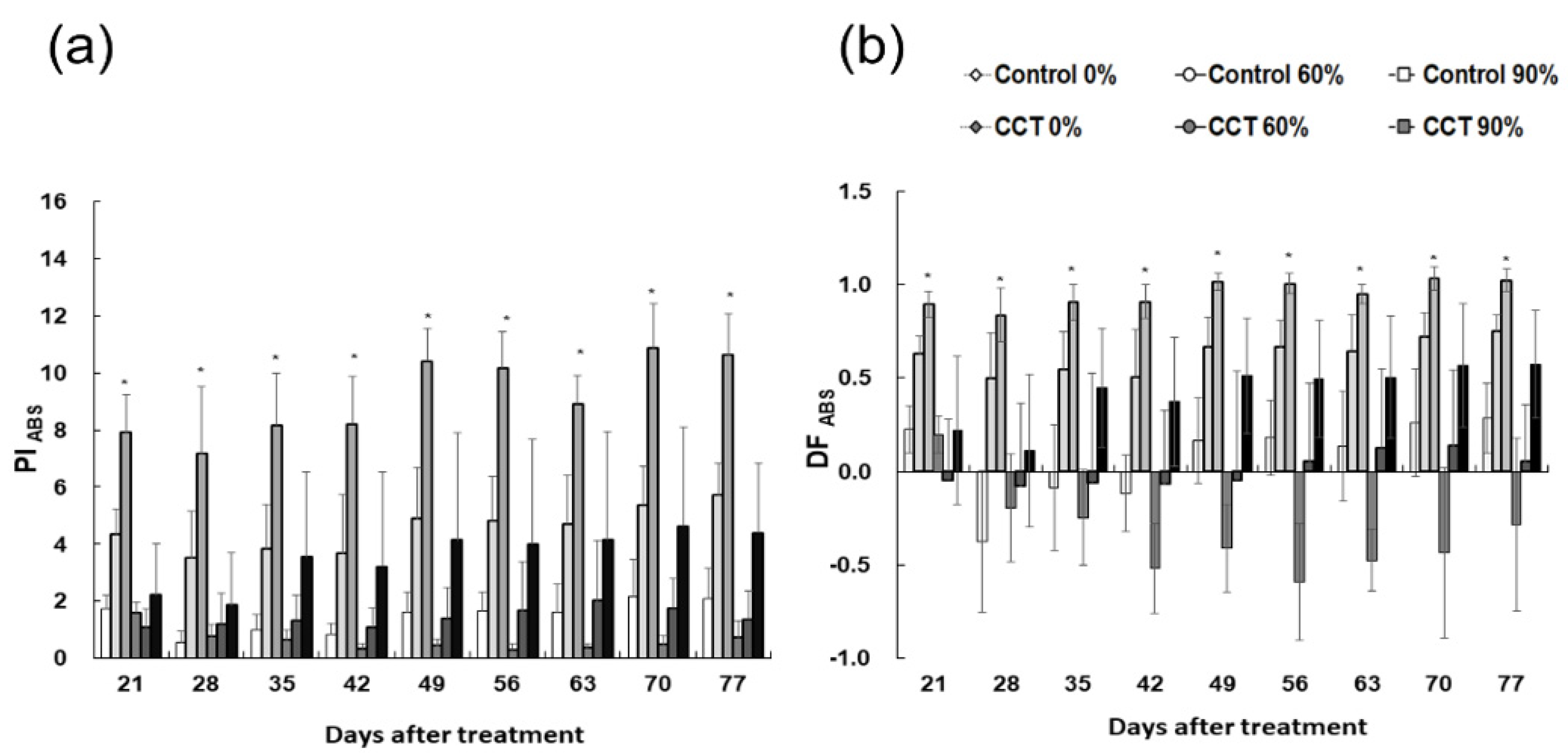Effects of Light Condition on Growth and Physiological Characteristics of the Endangered Species Sedirea japonica under RCP 6.0 Climate Change Scenarios
Abstract
:1. Introduction
2. Results and Discussion
2.1. Comparison of Environmental Conditions
2.2. Daily Change in CO2 Absorption Rate and Stomatal Response
2.3. Chlorophyll Fluorescence Response
2.4. Chlorophyll and Carotenoid Contents
2.5. Growth Characteristics
3. Materials and Methods
3.1. Materials and Experimental Design
3.2. Daily Changes in CO2 Absorption Rate and Stomatal Response
3.3. Chlorophyll Fluorescence Response
3.4. Chlorophyll and Carotenoid Contents
3.5. Growth Characteristics
4. Conclusions
Author Contributions
Funding
Data Availability Statement
Conflicts of Interest
References
- Kim, Y.K.; Jo, S.J.; Kim, K.J. Phylogenetic position of Neofinetia and Sedirea (Orchidaceae) and their species identification using the chloroplast matK and the nuclear ITS sequences. Korean J. Plant Taxon. 2014, 44, 39–50. [Google Scholar] [CrossRef]
- Suetsugu, K.; Tanaka, K. Pollination of Sedirea japonica (Orchidaceae) by Bombus diversus diversus (Hymenoptera: Apidae). Eur. J. Entomol. 2013, 110, 545. [Google Scholar] [CrossRef] [Green Version]
- Shim, Y.J.; Park, Y.S.; Jang, R.H.; Yoon, Y.J.; Kim, S.R.; Han, S.H. The development of Habitat Suitability Index Model of Class I endangered wildlife, Sedirea japonica. J. Korean Isl. 2020, 32, 153–172. [Google Scholar] [CrossRef]
- IPCC (Intergovernmental Panel on Climate Change). Climate Change 2014: Synthesis Report. Contribution of Working Group I, II and III to the Fifth Assessment Report of the Intergovernmental Panel on Climate Change; IPCC: Geneva, Switzerland, 2014; pp. 1–151.
- Lee, S.I.; Lee, E.P.; Kim, E.J.; Park, J.H.; Cho, K.T.; Lee, S.Y.; You, Y.H. Growth response and variation of ecological niche breadth of Hibiscus hamabo, the endangered plant, according to light, moisture and nutrient under elevated CO2 concentration and temperature. Korean J. Environ. Ecol. 2017, 31, 279–286. [Google Scholar] [CrossRef]
- Newth, D.; Gunasekera, D. Projected changes in wet-bulb globe temperature under alternative climate scenarios. Atmosphere 2018, 9, 187. [Google Scholar] [CrossRef] [Green Version]
- Korea Meteorological Administration. Analysis of Climate Change Forecasts on the Korean Peninsula; Korea Meteorological Adiminstration: Seoul, Korea, 2018; p. 16.
- Norby, R.J.; Wullschleger, S.D.; Gunderson, C.A.; Nietch, C.T. Increased growth efficiency of Quercus alba trees in a CO2-enriched atmosphere. New Phytol. 1995, 131, 91–97. [Google Scholar] [CrossRef]
- Huang, J.G.; Bergeron, Y.; Denneler, B.; Berninger, F.; Tardif, J. Response of forest trees to increased atmospheric CO2. CRC Crit. Rev. Plant Sci. 2007, 26, 265–283. [Google Scholar] [CrossRef]
- Drennan, P.M.; Nobel, P.S. Responses of CAM species to increasing atmospheric CO2 concentrations. Plant Cell Environ. 2000, 23, 767–781. [Google Scholar] [CrossRef] [Green Version]
- Zhu, P.; Zhuang, Q.; Ciais, P.; Welp, L.; Li, W.; Xin, Q. Elevated atmospheric CO2 negatively impacts photosynthesis through radiative forcing and physiology mediated climate feedback. Geophys. Res. Lett. 2017, 44, 1956–1963. [Google Scholar] [CrossRef] [Green Version]
- Osmond, C.B. Crassulacean acid metabolism: A curiosity in context. Annu. Rev. Plant Physiol. 1978, 29, 379–414. [Google Scholar] [CrossRef]
- Hopkins, W.G.; Hüner, N.P.A. Introduction to Plant Physiology, 4th ed.; John Wiley and Sons: New York, NY, USA, 2008; pp. 223–230. [Google Scholar]
- Zhu, J.; Goldstein, G.; Bartholomew, D.P. Gas exchange and carbon isotope composition of Ananas comosus in response to elevated CO2 and temperature. Plant Cell Environ. 1999, 22, 999–1007. [Google Scholar] [CrossRef]
- Nobel, P.S.; Israel, A.A.; Wang, N. Growth, CO2 uptake, and responses of the carboxylating enzymes to inorganic carbon in two highly productive CAM species at current and doubled CO2 concentrations. Plant Cell Environ. 1996, 19, 585–592. [Google Scholar] [CrossRef]
- Hogewoning, S.W.; van den Boogaart, S.A.; van Tongerlo, E.; Trouwborst, G. CAM-physiology and carbon gain of the orchid Phalaenopsis in response to light intensity, light integral and CO2. Plant Cell Environ. 2021, 44, 762–774. [Google Scholar] [CrossRef] [PubMed]
- Winter, K.; Smith, J.A.C. Crassulacean acid metabolism: Current status and perspectives. In Crassulacean Acid Metabolism; Ecological studies (analysis and synthesis); Winter, K., Smith, J.A.C., Eds.; Springer: Berlin/Heidelberg, Germany, 1996; pp. 230–246. [Google Scholar]
- Huerta, A.J.; Ting, I.P. Effects of various levels of CO2 on the induction of Crassulacean acid metabolism in Portulacaria afra (L.) Jacq. Plant Physiol. 1988, 88, 183–188. [Google Scholar] [CrossRef] [Green Version]
- Winter, K.; Zotz, G.; Baur, B.; Dietz, K.J. Light and dark CO2 fixation in Clusia uvitana and the effects of plant water status and CO2 availability. Oecologia 1992, 91, 47–51. [Google Scholar] [CrossRef]
- Graham, E.A.; Nobel, P.S. Long-term effects of a doubled atmospheric CO2 concentration on the CAM species Agave Deserti. J. Exp. Bot. 1996, 47, 61–69. [Google Scholar] [CrossRef] [Green Version]
- Cui, M.; Miller, P.M.; Nobel, P.S. CO2 exchange and growth of the Crassulacean acid metabolism plant Opuntia ficus-indica under elevated CO2 in open-top chambers. Plant Physiol. 1993, 103, 519–524. [Google Scholar] [CrossRef] [Green Version]
- Lim, N.H.; Lee, H.B.; An, S.K.; Kim, K.S. Acclimation of young Doritaenopsis Queen Beer ‘Mantefon’ plants under increased CO2 concentration. Flower Res. J. 2018, 26, 11–18. [Google Scholar] [CrossRef]
- Strasser, R.J.; Srivastava, A.; Tsimilli-Michael, M. The fluorescence transient as a tool to characterize and screen photosynthetic samples. In Probing Photosynthesis: Mechanism, Regulation and Adaptation; Yunus, M., Pathre, U., Mohanty, P., Eds.; Taylor and Francis: London, UK; New York, NY, USA, 2000; pp. 445–483. [Google Scholar]
- Wang, Z.X.; Chen, L.; Ai, J.; Qin, H.Y.; Liu, Y.X.; Xu, P.L.; Jiao, Z.Q.; Zhao, Y.; Zhang, Q.T. Photosynthesis and activity of photosystem II in response to drought stress in amur grape (Vitis amurensis Rupr.). Photosynthetica 2012, 50, 189–196. [Google Scholar] [CrossRef]
- Ceusters, N.; Valcke, R.; Frans, M.; Claes, J.E.; Van den Ende, W.; Ceusters, J. Performance index and PSII connectivity under drought and contrasting light regimes in the CAM orchid Phalaenopsis. Front Plant Sci. 2019, 10, 1012. [Google Scholar] [CrossRef] [Green Version]
- Holland, V.; Koller, S.; Brüggemann, W. Insight into the photosynthetic apparatus in evergreen and deciduous European oaks during autumn senescence using OJIP fluorescence transient analysis. Plant Biol. 2013, 16, 801–808. [Google Scholar] [CrossRef]
- Begovic, L.; Galic, V.; Abicic, I.; Loncaric, Z.; Lalic, A.; Mlinaric, S. Implications of intra-seasonal climate variations on chlorophyll a fluorescence and biomass in winter barley breeding program. Photosynthetica 2020, 58, 995–1008. [Google Scholar] [CrossRef]
- Evans, J.R. The dependence of quantum yield on wavelength and growth irradiance. Funct. Plant Biol. 1987, 14, 69–79. [Google Scholar] [CrossRef]
- Thomas, T.; Lei, R.T.; Kitao, M.; Koike, T. Functional relationship between chlorophyll content and leaf reflectance and light-capturing efficiency of Japanese forest species. Physiol. Plant 1996, 96, 411–418. [Google Scholar]
- Gibson, K.D.; Fischer, A.J.; Foin, T.C. Shading and the growth and photosynthetic responses of Ammannia conninnea. Weed Res. 2001, 41, 59–67. [Google Scholar] [CrossRef]
- Eichelmann, H.; Oja, V.; Rasulov, B.; Padu, E.; Bichele, I.; Pettai, H.; Mand, P.; Kull, O.; Laisk, A. Adjustment of leaf photosynthesis to shade in a natural canopy: Reallocation of nitrogen. Plant Cell Environ. 2005, 28, 389–401. [Google Scholar] [CrossRef]
- Lee, S.J.; Oh, C.Y.; Han, S.H.; Kim, K.W.; Kim, P.G. Photosynthetic responses of Populus alba x glandulosa to elevated CO2 concentration and air temperature. Korean J. Agric. For. Meteorol. 2014, 16, 22–28. [Google Scholar] [CrossRef] [Green Version]
- Taiz, L.; Zeiger, E. Plant Physiology, 4th ed.; Sinauer Associates: Sunderland, MA, USA, 2006; p. 55. [Google Scholar]
- Popp, M.; Janett, H.P.; Lüttge, U.; Medina, E. Metabolite gradients and carbohydrate translocation in rosette leaves of CAM and C3 bromeliads. New Phytol. 2003, 157, 649–656. [Google Scholar] [CrossRef] [PubMed]
- Poorter, H.; Perez-Soba, M. Plant growth at elevated CO2. In Encyclopedia of Global Change, Volume 2: The Earth system: Biological and Ecological Dimensions of Global Environmental Change; John Wiley and Sons: Chinchester, UK, 2002; pp. 489–496. [Google Scholar]
- Ziska, L.H.; Hogan, K.P.; Smith, A.P.; Drake, B.G. Growth and photosynthetic response of nine tropical species with longterm exposure to doubled carbon dioxide. Oecologia 1991, 86, 383–389. [Google Scholar] [CrossRef] [PubMed]
- Kim, H.J.; Cho, A.R.; Park, K.S.; Kim, Y.J. Effect of CO2 enrichment on growth and flowering of Phalaenopsis. Hort. J. 2017, OKD-027. [Google Scholar] [CrossRef] [Green Version]
- Nogueira, A.; Martinez, C.A.; Ferreira, L.L.; Prado, C.H.B.A. Photosynthesis and water use efficiency in twenty tropical tree species of differing succession status in a Brazilian reforestation. Photosynthetica 2004, 42, 351–356. [Google Scholar] [CrossRef]
- Zheng, W.P.; Wang, P.; Zhang, H.X.; Zhou, D. Photosynthetic characteristics of the cotyledon and first true leaf of castor (Ricinus communis L.). Aust. J. Crop Sci. 2011, 5, 702–708. [Google Scholar]
- Hiscox, J.D.; Israelstam, G.F. A method for the extraction of chlorophyll from leaf tissue without maceration. Can. J. Bot. 1979, 57, 1332–1334. [Google Scholar] [CrossRef]
- Arnon, D.I. Copper enzymes in isolated chloroplasts. Polyphenoloxidase in Beta vulgaris. Plant Physiol. 1949, 24, 1–15. [Google Scholar] [CrossRef] [Green Version]
- Lichtenthaler, H.K. Chlorophylls and carotenoids: Pigments of photosynthetic biomembranes. Methods Enzymol. 1987, 148, 350–382. [Google Scholar]






| Treatment | Chlorophyll Content (mg g−1) | Carotenoid Content (mg g−1) | Chl a/b | T chl/Car | ||
|---|---|---|---|---|---|---|
| a | b | a + b | ||||
| Control 0% | 2.95 ± 0.36 | 0.60 ± 0.13 | 3.55 ± 0.49 | 1.17 ± 0.12 | 4.99 ± 0.58 | 3.02 ± 0.15 |
| Control 60% | 4.12 ± 0.81 | 1.26 ± 0.17 | 5.37 ± 0.66 | 1.40 ± 0.20 | 3.38 ± 1.06 | 3.86 ± 0.07 |
| Control 90% | 6.10 ± 0.52 | 1.35 ± 0.22 | 7.44 ± 0.64 | 1.66 ± 0.11 | 4.60 ± 0.82 | 4.48 ± 0.32 |
| CCT 0% | 2.86 ± 0.40 | 0.60 ± 0.04 | 3.46 ± 0.40 | 1.09 ± 0.19 | 4.81 ± 0.76 | 3.19 ± 0.22 |
| CCT 60% | 4.26 ± 0.46 | 1.00 ± 0.18 | 5.26 ± 0.59 | 1.25 ± 0.14 | 4.29 ± 0.50 | 4.20 ± 0.26 |
| CCT 90% | 5.62 ± 0.07 | 1.41 ± 0.03 | 7.03 ± 0.10 | 1.56 ± 0.04 | 3.99 ± 0.09 | 4.53 ± 0.05 |
| CCT | ns | ns | ns | * | ns | * |
| Shading | ** | ** | ** | ** | * | ** |
| CCT × Shading | ns | ns | ns | ns | ns | ns |
| Treatment | No. of Leaves | Dry Mass Production (g) | Leaf Thickness (mm) | Leaf Area (cm2) | T/R Ratio (g g−1) | SLA (cm2 g−1) | LAR (g g−1) | LWR (g g−1) | ||
|---|---|---|---|---|---|---|---|---|---|---|
| Leaf | Root | Total | ||||||||
| Control 0% | 4.6 ± 1.3 | 0.22 ± 0.09 | 0.32 ± 0.1 | 0.54 ± 0.19 | 1.50 ± 0.11 | 39.6 ± 15.8 | 0.66 ± 0.14 | 187.5 ± 29.6 | 73.0 ± 6.6 | 0.39 ± 0.05 |
| Control 60% | 5.0 ± 1.0 | 0.31 ± 0.05 | 0.40 ± 0.09 | 0.72 ± 0.13 | 1.65 ± 0.08 | 59.8 ± 6.8 | 0.80 ± 0.12 | 191.1 ± 13 | 85.0 ± 12.1 | 0.44 ± 0.04 |
| Control 90% | 5.6 ± 1.1 | 0.33 ± 0.06 | 0.39 ± 0.03 | 0.72 ± 0.08 | 1.63 ± 0.12 | 68.9 ± 8.1 | 0.87 ± 0.12 | 207.6 ± 15.5 | 95.9 ± 7.5 | 0.46 ± 0.03 |
| CCT 0% | 4.6 ± 0.6 | 0.22 ± 0.09 | 0.24 ± 0.10 | 0.46 ± 0.19 | 1.64 ± 0.11 | 45.3 ± 12.9 | 0.96 ± 0.14 | 211.1 ± 24.7 | 103.2 ± 16.6 | 0.49 ± 0.03 |
| CCT 60% | 4.4 ± 0.9 | 0.23 ± 0.05 | 0.23 ± 0.04 | 0.46 ± 0.09 | 1.61 ± 0.11 | 53.5 ± 6.7 | 0.98 ± 0.06 | 239.5 ± 28.7 | 118.0 ± 11.5 | 0.50 ± 0.02 |
| CCT 90% | 4.4 ± 0.9 | 0.27 ± 0.08 | 0.27 ± 0.06 | 0.53 ± 0.14 | 1.58 ± 0.05 | 64.0 ± 15.9 | 0.99 ± 0.08 | 242 ± 13.9 | 120.2 ± 4.3 | 0.50 ± 0.02 |
| CCT | ns | ns | ** | * | ns | ns | ** | ** | ** | ** |
| Shading | ns | * | ns | ns | ns | ** | ns | * | * | ns |
| CCT × Shading | ns | ns | ns | ns | ns | ns | ns | ns | ns | ns |
| Parameters | Description |
|---|---|
| VJ | Relative variable fluorescence at the J-step |
| VI | Relative variable fluorescence at the I-step |
| Vk | Relative variable fluorescence at the k-step |
| ΦPO (= TRo/ABS) | Probability that an absorbed photon leads to reduction further than QA- |
| ΦEO (= ETo/ABS) | Probability that an absorbed photon leads to electron transport further than QA- |
| ΨO (= ETo/TRo) | Probability that an absorbed photon leads to reduction of QA- |
| ABS/RC | Absorption flux per reaction center |
| TR0/RC | Trapped energy flux per reaction center |
| ET0/RC | Electron transport flux from QA to QB per reaction center |
| DI0/RC | Energy dissipation flux per reaction center |
| RE0/RC | Electron transport flux until PSI acceptors per reaction center |
| RE0/TR0 | Efficiency with which a trapped exciton can move an electron into the electron transport chain from QA–to the PSI end electron acceptors |
| PIABS | Performance index on absorption basis. |
| DFABS | Driving force on absorption basis. |
Publisher’s Note: MDPI stays neutral with regard to jurisdictional claims in published maps and institutional affiliations. |
© 2021 by the authors. Licensee MDPI, Basel, Switzerland. This article is an open access article distributed under the terms and conditions of the Creative Commons Attribution (CC BY) license (https://creativecommons.org/licenses/by/4.0/).
Share and Cite
Lee, K.C.; An, J.; Hwang, J.E.; Kim, P.B.; Park, H.B.; Kim, S.; Park, H.J.; Lee, C.W.; Lee, B.-D.; Kim, N.Y. Effects of Light Condition on Growth and Physiological Characteristics of the Endangered Species Sedirea japonica under RCP 6.0 Climate Change Scenarios. Plants 2021, 10, 1891. https://doi.org/10.3390/plants10091891
Lee KC, An J, Hwang JE, Kim PB, Park HB, Kim S, Park HJ, Lee CW, Lee B-D, Kim NY. Effects of Light Condition on Growth and Physiological Characteristics of the Endangered Species Sedirea japonica under RCP 6.0 Climate Change Scenarios. Plants. 2021; 10(9):1891. https://doi.org/10.3390/plants10091891
Chicago/Turabian StyleLee, Kyeong Cheol, Jiae An, Jung Eun Hwang, Pyoung Beom Kim, Hyeong Bin Park, Seongjun Kim, Hwan Joon Park, Chang Woo Lee, Byoung-Doo Lee, and Nam Young Kim. 2021. "Effects of Light Condition on Growth and Physiological Characteristics of the Endangered Species Sedirea japonica under RCP 6.0 Climate Change Scenarios" Plants 10, no. 9: 1891. https://doi.org/10.3390/plants10091891






